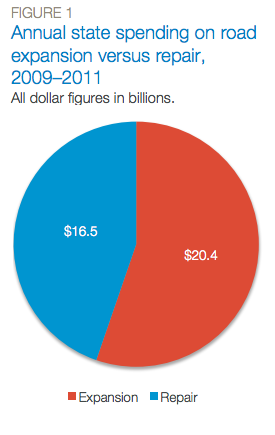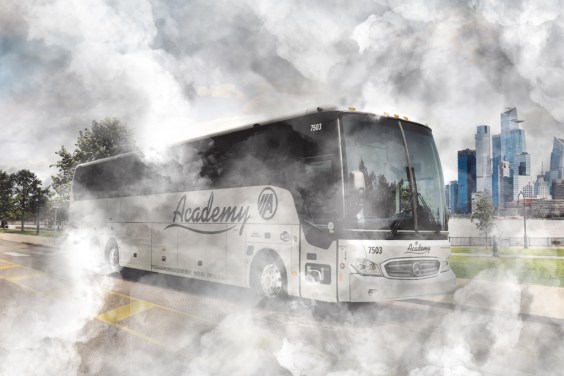
Pressure is mounting on the president and Congress to keep roads and bridges from falling apart by increasing transportation funding. But a big part of the problem is states, which receive the lion's share of federal transportation funds but opt to spend most on new roads, instead of maintaining existing infrastructure.
Between 2009 and 2011, states spent just 45 percent of their highway money maintaining the 900,000 miles of roads they control, according to Smart Growth America. Meanwhile, they poured 55 percent into road expansions. Some states spent more wisely and some spent more irresponsibly. The worst spent upward of 90 percent of their budgets on new construction during that time period.
And that's always been their prerogative. Most of the tens of billions of dollars in federal funding that flows to states every year comes with few strings attached. The system is also opaque: Determining how states spend their money is extraordinarily difficult.
How can people demand better from their state DOT if they can't tell what their DOT is doing? Advocates see greater transparency as an important tool for change, and they're fighting to implement strong new federal standards to grade state DOTs on safety, maintenance, and other key indicators.
MAP-21, the transportation bill enacted in 2012, included provisions for U.S. DOT to hold states to a new set of performance standards. Now, two years after passage, policy makers at the agency are beginning to define those metrics. For the most part, the law doesn't penalize failure to hit targets, but its reporting requirements could compel state DOTs to be publicly accountable for their decisions -- provided they're stringent enough.
In March, U.S. DOT released its first set of proposed standards, which were related to safety. The initial draft included no targets to reduce bike and pedestrian deaths and made it exceedingly easy for states to get a passing grade, but advocates flagged the problems and hope the final rule will be much stronger.
U.S. DOT has introduced the second round of performance measures, and this batch relates to road and bridge maintenance. The new rules, which are open to public comment, will compel states to be much more transparent about the conditions of the assets they control and how their spending decisions will influence those conditions, said Transportation for America's Beth Osborne.
"States are going to have to cop to this stuff now," she said. "Is your priority to build that new increment so much, you’re willing to watch the rest of the infrastructure deteriorate? This will allow a much better push and pull with the public." There is a financial incentive, too -- states that fail to keep roads in good condition will be required to spend a certain amount on maintenance until they pass.
The measures will be much more effective, says Osborne, if states and metropolitan planning organizations are required to explain how projects listed in their Statewide Transportation Improvement Programs -- basically, a list of projects in line for funding -- will affect performance goals. For example, if a state wants to proceed with an expensive highway project, it would have to note how that will affect maintenance outcomes.
Transportation for America says it's important for people who care about smart transportation policy to provide feedback to U.S. DOT on proposed performance measures. T4A is asking supporters to sign this letter to U.S. DOT to help ensure that the maintenance requirements will be exacting enough to make an impact.
The third round of performance measures, a draft of which has not yet been released, will focus on congestion and environmental outcomes. Stay tuned.





